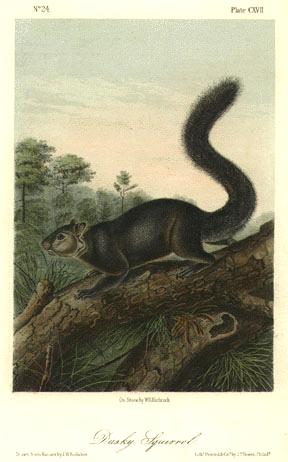

117 Dusky Squirrel
SCIURUS NIGRESCENS.--BENNETT.
[Sciurus griseus nigripes (subspecies)]
DUSKY SQUIRREL.
[Western Gray Squirrel]
PLATE CXVII.--MALE.
S. Subniger, corpore griseo sparsim vario, lateribus flavo-fuscescentibus
cauda corpore multo longiore.
CHARACTERS.
Prevailing colour dusky, slightly grizzled on the body with gray; sides,
dusky yellow; tail much longer than the body.
SYNONYMES.
SCIURUS NIGRESCENS. Bennett, Proceedings of the Zoological Society.
SCIURUS NIGRESCENS. Bachman, Monog. Genus Sciurus, read before the Zool.
Soc. August 14, 1838.
DESCRIPTION.
In size this species is nearly equal to the cat-squirrel (Sciurus
cinereus). Head, rather small; ears, of moderate size, not tufted; feet,
robust; tail, very long, and less distichous than in other squirrels, it
presenting in the stuffed specimen a nearly cylindrical shape; ears and feet,
clothed with short hairs; hairs of the body, short and close; whiskers, about
the length of the head.
COLOUR.
The prevailing colour on the back is grayish-black; crown of the head, and
legs, grayish; sides of the neck, upper parts of the thighs, and rump, grizzled
with pale yellow; cheek, chin, throat, neck, breast, and whole of the under
surface, including the inside of the legs, dingy gray; fore parts, same colour
as the back; hairs of hinder parts of thighs, black; hairs of the tail, black at
the roots, then gray, then broadly banded with black, then broadly tipped with
white; feet, black.
The hairs on the toes are grizzled with white points; whiskers, black;
hairs on the back, plumbeous--black from the roots for two thirds of their
length, then gray, then black, and at the tips whitish-gray; there are numerous
strong black hairs interspersed over the body.
DIMENSIONS.
Inches. Lines.
Length from point of nose to root of tail,. . . 12 4
Length of tail to end of hair,. . . . . . . 15 4
Length of tarsus (claws included), . . . . . 2 7 1/2
From tip of nose to ear,. . . . . . . . . 2 2
Height of ear posteriorly, . . . . . . . . 0 8 1/2
HABITS.
The existence in North America of an unusual number of species of squirrels
has been made known to our subscribers in the course of this publication. There
are many closely allied, and many very beautiful species among them; all are
graceful and agile, and possess very similar habits.
The great number of these nut-eating animals in North America would be a
proof (were any such wanting) that nature has been more bountiful to our country
in distributing nut-bearing trees over the whole extent of our continent than to
other parts of the globe, and this in connexion with the fact that so great a
proportion of wood-land cannot be found in any other part of the world of
similar extent, marks America as intended for a very dense population
thereafter. In Europe there is only one well determined species of squirrel
known, at present at least, although at some remote period there may have been
more.
In regard to the peculiar habits of the Dusky Squirrel, we have nothing to
say. It is one of the species which, being shot or procured by collectors of
objects of natural history, and sent to Europe, have there been described by
naturalists who, having the advantages of museums which contain specimens from
every part of the globe, and the largest libraries in the world also to which
they can refer, may sometimes discover new species with much less difficulty,
but also less certainty, than the student of nature must encounter while seeking
for knowledge in the woods.
But the naturalist who learns from books only, and describes from dried
skins, is at best liable to mistakes. We have in fact always found that where
young animals, or accidental varieties, have been described as new species, this
has been the result of study in the museum or cabinet, not in the fields.
GEOGRAPHICAL DISTRIBUTION.
This species, of which, so far as we know, only one specimen exists in any
museum or collection, is stated to have been procured in California. We have
not received any positive accounts of its occurrence there, but have no doubt it
will be found, and its habits, as well as locality, determined ere long.
GENERAL REMARKS.
This Squirrel was described by Dr. BACHMAN from the original specimen in
the museum of the Zoological Society of London, in his Monograph of the Genus
Sciurus, published in the Proceedings of the Zoological Society, and in the
Magazine of Natural History, new series, 1839, p. 113; and our figure was drawn
from the same skin by J. W. AUDUBON.
|